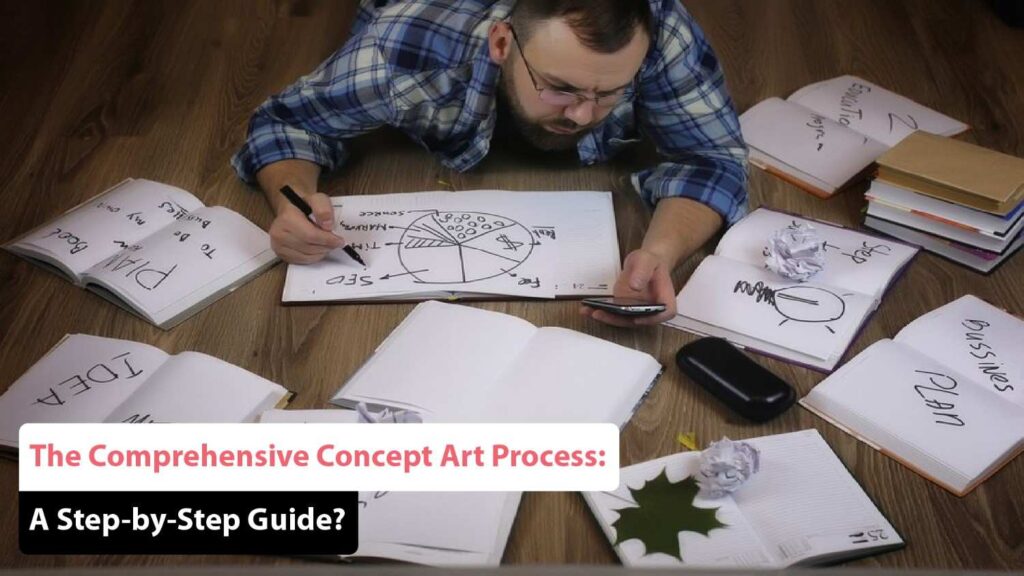
In the evolving creative industries of 2025, concept art continues to serve as the cornerstone of visual development in video games, animated films, television, and digital storytelling. From sprawling sci-fi landscapes to expressive characters, the job of a concept artist is to visually imagine worlds before they’re built.
This guide breaks down the concept art workflow step by step, helping both aspiring and professional artists navigate the ever-evolving process. Whether you’re just starting or fine-tuning your pipeline, this is your ultimate resource to create efficient, professional-level art in today’s creative landscape.
Word Count: ~1,765 words
What Is Concept Art?
Concept art is the visual planning stage of a creative project. It’s where ideas are formed, visualized, refined, and ultimately turned into the assets that guide 3D modeling, animation, and storytelling teams.
Concept artists are responsible for establishing tone, mood, style, and detail early in development. They work on everything from character design and environment concept art to props, vehicles, and user interfaces.
Concept Art Workflow Step by Step
1. Brief & Research Phase
The concept art journey starts with a brief, often delivered by a creative director or client. This brief outlines the goals, style direction, target audience, and scope of the design.
Key Actions:
- Read and analyze the project brief
- Conduct visual and contextual research
- Create mood boards and style references
This phase involves looking at existing movies, games, architecture, fashion, nature, and culture to build a visual vocabulary for your designs.
2. Thumbnails & Ideation
This is where ideas begin to materialize. Quick, small sketches—known as thumbnails—help explore compositions, shapes, and silhouettes before committing to full designs.
Why thumbnails matter:
- Encourage experimentation
- Allow fast visual iteration
- Emphasize form and layout over detail
Whether you’re designing a sci-fi city or a fantasy beast, thumbnails give your imagination freedom.
3. Rough Sketches & Silhouettes
Take your strongest thumbnails and develop them into more detailed sketches. Silhouettes are often used here, particularly in character design and environment concept art, to refine shape language.
Goals:
- Establish a clear design structure
- Test scale and proportions
- Begin establishing character or environmental personality
How to Create Professional Concept Art
Creating high-level art involves moving from rough drafts to polished presentations that clearly communicate intent to stakeholders or production teams.
4. Refinement & Value Studies
Now that the shape and form are locked in, refine the sketch using line work and grayscale values to build depth and form. Focus on light, shadow, and readability.
Pro tips:
- Use 3-value studies (light, midtone, dark)
- Eliminate visual clutter
- Emphasize focal points
5. Color Exploration
Once values are locked, explore different color schemes. Use color theory to evoke emotion, highlight storytelling, and separate elements.
Tips:
- Use warm vs. cool contrast
- Apply atmospheric perspective for depth
- Reference real-world lighting
Best Tools for Concept Art in 2025
Digital artists in 2025 benefit from powerful software and AI-powered tools. Here are some of the best tools for concept art in 2025:
- Photoshop 2025 – Still the industry standard for painting, blending, and photo-bashing
- Procreate – Ideal for mobile sketching and quick iterations
- Blender – Free 3D software great for blocking environments and lighting
- Krita – Free and open-source alternative for painting
- Uizard AI – For layout-heavy UI/UX design projects
- Artbreeder & Midjourney – AI-driven generators for concept ideation and photobashing
By combining traditional painting skills with 3D and AI tools, artists now accelerate ideation and increase accuracy in production workflows.
Character Design and Environment Concept Art
Concept art can generally be divided into two main focuses: characters and environments. Each requires a unique approach.
Character Design
Character design involves visually defining a person, creature, or being in the project’s universe. It includes costume design, facial expression, body language, and cultural cues.
Key Considerations:
- Personality and story role
- Proportions and pose
- Accessories, clothing, color palette
- Expressiveness and emotion
Designs should be functional for 3D modelers and animators, which is why orthographic views and turnaround sheets are often required.
Environment Design
Environment concept art focuses on worldbuilding. It includes locations, props, architecture, foliage, and weather systems.
Goals:
- Establish mood, space, and lighting
- Guide level or set design
- Show environmental storytelling (e.g., ruins, clutter, lighting)
Designs can be painted or photo-bashed and often combine both 2D and 3D techniques.
Beginner’s Guide to Digital Concept Art
Starting digital concept art can be daunting, but you don’t need to master everything at once.
Step 1: Choose Your Tool
Start with a beginner-friendly app like Procreate or Krita. Master brushes, layers, and canvas control.
Step 2: Study the Fundamentals
Focus on drawing, perspective, anatomy, color theory, and light. These will serve you in every type of design.
Step 3: Start a Daily Sketch Routine
Dedicate 30–60 minutes per day to sketching, either from imagination or photo reference.
Step 4: Take Online Classes
Join platforms like ArtStation Learning, CGMA, or Learn Squared for structured courses.
Step 5: Build a Portfolio
Document your progress and create a portfolio of finished works and process breakdowns.
Concept Art Techniques for Game and Film
Producing artwork for games and films involves certain production constraints and pipelines.
Techniques for Game Development:
- Modular environment design
- Character silhouettes for gameplay clarity
- Orthographic turnaround sheets for 3D modeling
- Iconic shape language for readability
Techniques for Animation/Film:
- Dramatic lighting and cinematic framing
- Scene mood boards and keyframes
- High-resolution textures for matte painting
- Sequential storytelling visuals
Collaboration & Feedback in 2025
Collaboration is more digital than ever. Teams use Figma, Notion, Miro, and ArtStation for feedback.
Tips:
- Always include readable labels and color codes
- Present options, not just final renders
- Be open to iterative feedback loops
- Use reference sheets for consistency
AI & the Future of Concept Art
In 2025, AI doesn’t replace artists—it empowers them. Midjourney, Runway ML, and Adobe Firefly are tools to generate base ideas, textures, lighting references, and variations.
Best Uses of AI in Concept Art:
- Rapid thumbnail generation
- Mood board creation
- Quick background fills
- Photobash material generation
AI allows concept artists to iterate faster and push creativity further—but understanding fundamentals is still key.
Finalizing Your Concept Art
1. Polish Pass
Add final details: small objects, hair strands, texture, and rim lights. Ensure all lighting, shadows, and form are consistent.
2. Presentation
Layout your artwork professionally:
- Include callouts and notes
- Provide orthographics (front, side, back views)
- Use clean backgrounds and consistent framing
3. Delivery
Deliver files in required formats (PSD, PNG, or JPEG), and maintain layers for modelers or VFX teams.
Recap: Complete Concept Art Workflow
Here’s a condensed breakdown of the concept art workflow step by step:
- Read the brief & gather references
- Sketch thumbnails and ideation
- Develop rough sketches and silhouettes
- Create value studies
- Explore color palettes
- Polish and finalize rendering
- Present and deliver assets
Conclusion
Mastering concept art takes dedication, curiosity, and patience. By following this complete guide, you’ll not only understand how to create professional concept art but also learn how to adapt it for game and film industries using the latest tools.
With the right balance of creativity and production skill, concept art becomes one of the most exciting and impactful roles in the creative world.
Whether you’re exploring character design and environment concept art, investing in the best tools for concept art in 2025, or simply following a beginner’s guide to digital concept art, this is your foundation to grow and thrive.
Frequently Asked Questions (FAQ’s)
What is concept art?
Concept art is a visual representation used to convey the ideas and creative vision for a project. It includes illustrations of characters, environments, props, and key story elements, helping to define the look and feel of the project before production begins. Concept art serves as a foundational element that guides the entire production process and ensures consistency throughout.
Why is concept art important?
Concept art is crucial because it transforms abstract ideas into visual form, providing a clear guide for production teams. It helps establish a unified artistic direction, enables creative experimentation, catches potential issues early, and saves time and resources by clarifying the project’s visual goals. Without it, projects risk becoming disjointed and lacking a cohesive visual identity.
What are the main stages of creating concept art?
The main stages include:
- Concept Development: Defining the overall vision and gathering reference materials to ground the art in reality.
- Thumbnail Sketches: Exploring different compositions and visual options through small, rough sketches to quickly assess various directions.
- Tighter Rough Sketches: Refining selected ideas with more detail and specificity to get closer to the final design.
- Monochromatic Value Art: Creating grayscale or limited-color studies to analyze lighting, composition, and perspective before full color is applied.
- Final Painting and Details: Adding color, textures, and special effects to complete the concept art and provide a detailed guide for the production team.
How does concept art contribute to visual storytelling?
Concept art provides a visual blueprint that guides the development of characters, settings, and key scenes. It ensures that the story’s visual elements are cohesive and effectively communicate the intended mood and narrative, enhancing the overall storytelling experience. By visualizing these elements early, concept art helps maintain a consistent and engaging narrative throughout the project.
What types of concept art are commonly used?
Common types of concept art include:
- Character Concept Art: Designs for characters, including their appearance, costumes, and unique traits, help define their role and personality.
- Environment Concept Art: Illustrations of settings and backgrounds that establish the mood and context of the story, helping to create immersive worlds.
- Vehicle/Prop Concept Art: Designs for objects and vehicles that contribute to the functionality and visual coherence of the project.
- Storyboarding: Sequences of illustrations outlining key scenes and actions, aiding in visualizing the narrative flow and transitions.
- Matte Paintings: Detailed backgrounds and environments are used to create expansive scenes and enhance the visual depth and realism of the setting.





